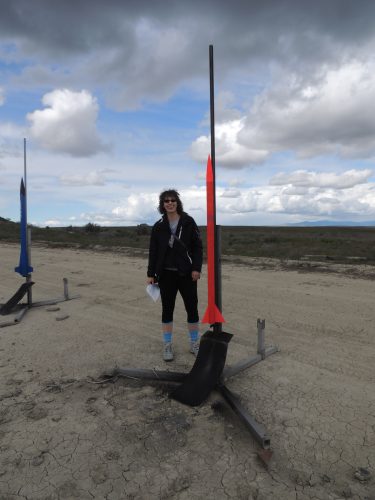
The UW Department of Earth and Space Sciences’ Erika Harnett is a geophysicist who studies weather in space. She looks at how solar wind interacts with weakly magnetized planets, like the Moon or Mars. Among other things, Erika is also the is the Associate Director of the Washington NASA Space Grant Consortium.
She’ll be in eastern Oregon for the upcoming Total Solar Eclipse on August 21, and in advance of the once-in-a-lifetime solar event, we caught up with her. In this quick Q&A, she tells us more about eclipses, why this one is special and the kinds of data she and her team will be collecting as it happens.
What is a solar eclipse?
A solar eclipse is when the Moon passes between the Earth and the Sun, and the shadow of the Moon falls on the Earth. The Moon’s orbital period is 27 days, so you might think that this should happen once a month. In fact, it happens only about every 18 months because the plane the Moon orbits in is not aligned with the Earth’s equator. Most of the time, that means the shadow does not fall on the Earth.
Also, the upcoming eclipse is a total eclipse, which means that the Moon will completely block the view of the Sun in the path of totality. Because the Moon’s orbit is also not a perfect circle, sometimes eclipses occur and the Moon appears to be smaller than the Sun (it is called an annular eclipse).
What makes the upcoming eclipse so special?
What makes this event special is that this is the first total eclipse viewable from the U.S. since 1979, and the path of totality will go from one coast to the other, creating a large swath in which people from around the country will be able to see the eclipse.
You’ll be in Oregon collecting data as the eclipse happens. What kind of information will you be collecting?
I will be in Culver, Oregon assisting with high altitude balloon launches — provided the forest fire nearby doesn’t get any closer! The hope is that cameras on the balloons will be able to capture pictures of the shadow on the Earth, and record atmospheric changes associated with the rapid decrease in temperature that will occur during the eclipse. While many of those observations could be done other ways, there has been an orchestrated effort on the part of NASA Space Grant offices to use this event as a teaching moment. All of the balloon teams around the country have significant effort by students in building and launching the balloons. It is hoped that this will spur increased scientific ballooning capacity at high schools and universities throughout the country.
What challenges do you face in relation to this type of data gathering?
Getting to the location and recovering the balloons afterwards! There are predictions of very large traffic jams as the result of the large number of people traveling to rural areas that do not have the roadway infrastructure to support so many visitors.
What can people in Seattle expect to see (or not see) during the eclipse?
People in the greater Seattle area will be able to see between 92-95 percent of the Sun blocked by the Moon. It will never be safe to look at the Sun without special eye protection to decrease the intensity of the Sun or through special solar viewing telescopes. But enough of the Sun will be blocked for air temperatures to decrease significantly, which is likely to cause a marine layer to form over our waterways and clouds to form. If the marine layer push is not too strong, people should also see the brightness of the day decrease significantly, but it will not become completely dark.
Should non-scientists be interested in the eclipse?
Of course! A total eclipse is something few people get to see in their lifetimes. It also gives people an opportunity to experience the wonder of a celestial event and think about our place in the universe.
What kinds of opportunities does an event like this provide to scientists working in your field?
Total solar eclipses were used in the past to prove Einstein’s Theory of Relativity, as scientists were able to observe light from stars directly behind the Sun, off to the side of the Sun. This proved the Sun’s mass was bending the light so that scientists could see what was behind the Sun. Now a total eclipse allows scientists to view the extended atmosphere around the Sun (called the corona) at totality, and identify structure within the corona associated with the Sun’s magnetic field.

